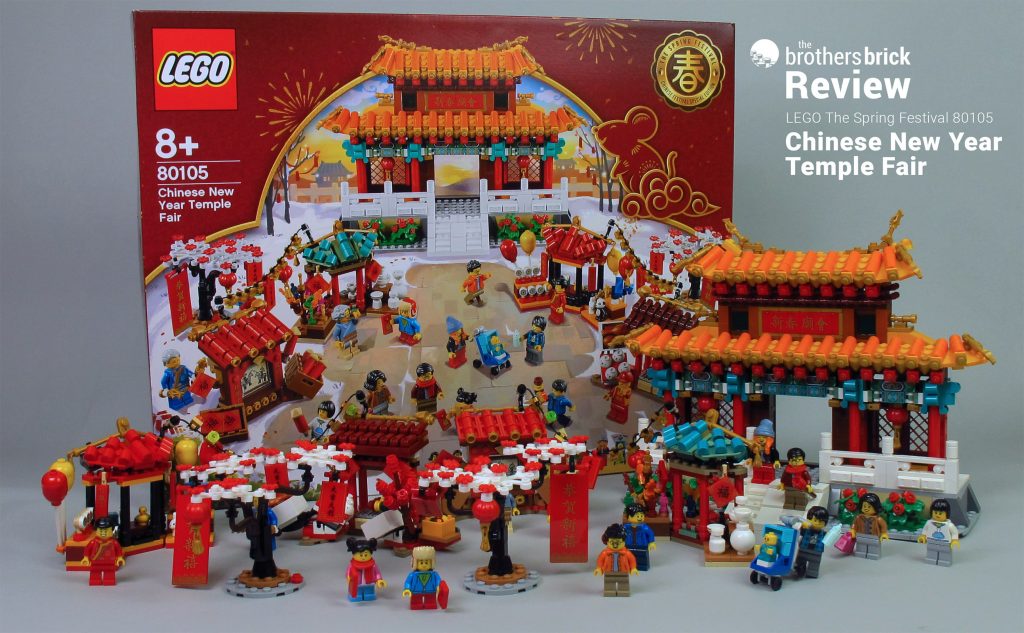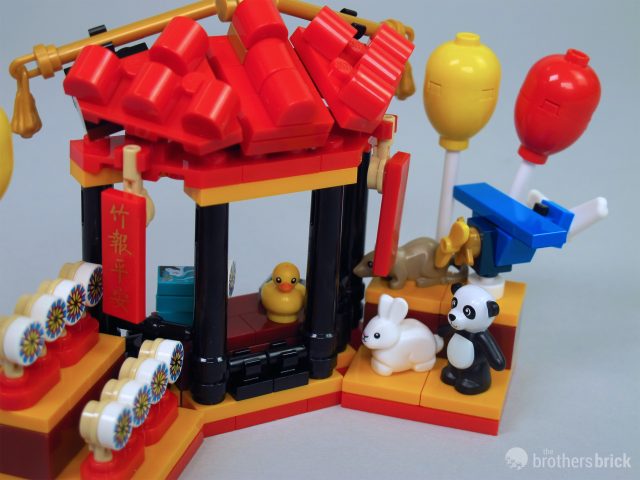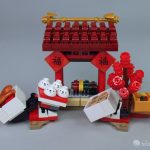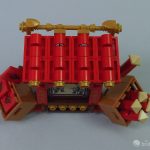Last year, LEGO released sets 80101 Chinese New Year’s Eve Dinner and 80102 Dragon Dance to celebrate the Chinese Spring Festival, also known as the Lunar New Year (or Chinese New Year). At the time, the sets were only sold in the Asia Pacific region, causing an uproar among fans elsewhere in the world who felt slighted by their regional exclusivity. The extent of this reaction was influential in LEGO’s decision to make this year’s Chinese New Year sets available worldwide. Today, we take a look at this year’s LEGO 80105 Chinese New Year Temple Fair to give you insight into a brick-built celebration filled with fun and beautiful details. The set has been available in the Asia Pacific region since December 26, 2019 but is being released worldwide today. It consists of 1664 pieces and retails for US $119.99 | CAN $159.99 | UK £89.99
The Box, Instructions and Contents
The front of the box features the full play scene, while the back side includes some close-up shots of specific builds. January 25th marks the beginning of the Chinese New Year holiday, with 2020 ushering in the Year of the Rat, which is why LEGO has included the rat in the line art for both the front and back of the box. In the upper-right-hand corner of the front of the box, you will find the Chinese character for spring — 春 (Chūn), along with a note of it being a special edition set. Because red and gold are especially popular in Chinese culture, these colours are prominent in both the box art and selection of elements used in the build. Red represents joy, luck and happiness, while gold symbolizes wealth.
The parts are packaged in ten bags, with a pair of number 1 bags and 2 through 9. Another bag holds three instructions booklets — 2 small and 1 large. Since all the decorated elements a printed, there aren’t any stickers in this set.
The completed scene consists of a large temple gate facade as the main structure, four smaller market stalls and a pair of identical trees in bloom. The actual build starts off with a tree, followed by two market stalls and the temple gate. Things wind down with the second tree and the final two market stalls. The sequence was carefully thought out, as it actually increases the fun factor by allowing the scene to gradually come to life as opposed to a mundane and predictable pattern. Despite this, we’re sharing the models in a slightly different order to maintain a logical approach for a written review.
The Temple Gate Structure
The base is built on an elevated platform that is 32 studs wide and includes a staircase.
At the base of the platform, four bright red flowering plants rest on each side of the staircase. The tightly packed design is delightful to look at, and the positioning and layering of the leaves avoids the typical hard edges of LEGO elements — The feel quite organic.
The structure is then built upward with a doorway in the middle, which in turn is flanked by two sections with windows. Decorative printed tiles go across from one end to the other and are supported by red beams.
The 1×4 tile is printed with a flower-like pattern on the sides and a swirling dragon in the centre. The 1×2 tiles feature a petal-like print in the centre.
The next layer of the build is the mid-roof structure. The orange 1×1 modified curved brick is a perfect use for the familiar texture of temple roofing in classic Chinese architecture.
Once in place, the contrast between the yellows, red and medium azure allow the structure to come to life. The little lanterns certainly help, too!
The majority of the roof section is built in a repetitive manner, with the two ends forming an elegant gradual curve. A gold telescope element and dragon head sword hilt are used for detailing the corners.
A white gate is added to complement the staircase and entrance, and signage is attached above the eaves. From an architectural standpoint, ancient Chinese roofs had wide eaves, usually made from wood or stone, which could shield the walls from fierce wind-driven rain.
The characters 新春廟會 translate into Chinese New Year Temple Fair and are printed in gold ink.

A similar pattern is used for the second level with an upturned eave at the edge, which is most identifiable in traditional Chinese roof architectures. The array and combination of curves and lines increases the roof’s surface area, which in turn improves draining of rainwater and reduces stress under loads of snow during winter. While it’s also a symbol of hierarchy in ancient times, it’s both functional and aesthetically unique and pleasing. The end result is a stunningly beautiful temple gate with traditional roofing and graceful shapes.
The back of the structure is a clean design that can almost be flushed to the edge of a wall for display since it’s void of studs.
The Tree Build
Two trees are constructed to be placed near the other builds. Each one features a lantern with tassel, as well as two tiles hung from the branches.
The larger banner says 恭贺新禧 [gōng hè xīn xǐ], which translates into a congratulatory greeting for the new year “wishing happiness and good luck” in a respectful and formal way.
The smaller 2×6 tile says 大吉大利 [dàjídàlì], which translates to wishing great luck and great prosperity.
The tree looks great from all angles, especially with the contrast between white and red.
Besides the main structure, there are four stalls that surround the temple. Let’s take a look at each one in greater detail.
Tasting at the Food Stall
The food stall has dark red roofing accented with golden beams across the top, and it features a few snacks the festival-goers can enjoy when hungry.
The printed tile has one word, (fú) 福, which translates to several meanings including fortune and good luck.
A barbecue pit sits in the centre of the stall roasting skewers and, in true LEGO detailing, a small flame element is built underneath the grill slats to provide heat.
The food stall features various snacks, including skewers of food, fried foods (chicken drumsticks), Chinese hawthorn candy (山楂) and cookies.
The bowls with facial prints are likely Bāozi (包子), which are basically soft steamed buns that may be filled with meat or vegetables. They sometimes come with edible prints on them to make them a little more cute and attractive and, in this case, it’s an animal face print. My guess is the prints were added because having downward facing unprinted bowls would make things even more mysterious as to what they represent.
Beside the sticks of hawthorn candy is a table for preparing the skewers. There’s a cleaver and several unused skewers on-hand while the uncooked meat is prepared on a chopping board.
The rear section of the food stall has a little 1×1 timer and a lever to control the temperature of the grill.
The food stall is connected to a toy store with a string of lighting and lanterns as decorations.
The smaller printed plate we saw on the tree earlier reused here, wishing great luck and prosperity to the visitors at the fair. Let’s walk over to the toy stall to see what’s in store for us.
Exploring the Toy Stall
The toy store features balloons on either side with decorative fans and, according to the designer Marcus Rollbühler, a bunch of stuffed animals. I was hoping they were live animals visitors could take home. There’s also a microscale plane on the side, which seems a bit out of place among all the animals.
We get a teddy bear / panda bear that makes a comeback from the 2014 LEGO Movie Collectible Minifigures, a rabbit, a duck and a mouse (appropriate for celebrating the Year of the Rat).
The back view shows where the stall owner would be standing and has features like a calculator and several 1×1 tiles which I’d assume to be gift boxes or tiny trinkets. The topmost teal tile has a unicorn printing. This appeared last (and only once) in the Trafalgar Square Set.
The Shadow Theatre
Moving on to the shadow theatre, this is my favourite of them all because of the arsenal of fireworks! The shadow puppetry scene is printed on a window element and shows two warriors in a jousting battle. To the left of the show, there are printed leaflets for sale featuring the tile we first encountered at the food stall, (fú) 福 for fortune and luck.
Two printed tiles are featured on the front facade. These are the same tiles from the Toy Store. The tile on the left is printed with [huā kāi fù guì] (花开富贵), expressing the ‘blossoming of wealth,’ while the right tile [zhú bào píng ān] (竹报平安) wishes ‘blessings of peace.’
The rear of the stall features two other shadow puppets hanging off by the side, a tiny minifigure and dragon to enhance the stories to be told.
The scene is made livelier with the minifigures in place, including the shadow puppet master ready to put on a show.
Just like the food stall and toy stall, the shadow theatre is connected to the vase store by a string of lights and lanterns.

The Vase Store
The vase store sells vases, pottery and porcelain dolls. The pottery parts are made up of white elements while the doll figures are made up of micro figures in various colors.
The micro figures come in six different colors, and the image below includes the spares that come with the set.
The back of the stall features a quill pen and a calculator.
The two interconnected builds also feature a second tree built with the exact same elements, as seen on the right.
A Study of Roofing Techniques
While building the set as a whole, the an area that stood out to me was the various techniques of roof design and tiling. These could be a source of inspiration and for fans and their custom builds.
The main building features interleaved rows of 1×1 modified curved bricks in orange with a yellow background and gold trim along the edges.
The food stall features Dark Red Bar Holders with handles on clips.
The shadow theatre features red 2×2 modified plate with pinholes and gold-coloured flowers at the edges.
The vase stall uses a similar approach to that of the main building, but at a smaller scale. Its roof utilizes 1×1 modified round bricks in teal on sand green plates.
The Minifigures
This set comes with a total of 14 Minifigures. Designer Marcus Rollbühler reminds us that these figures are an extension of last year’s Spring Festival sets, with the family now shown visiting their grandparents after their Chinese New Years dinner. Let’s take a look at them individually.
Before we dive into the minifigures, here’s a quick lesson on how Asians typically refer to each other. You might be used to using last names or first names when addressing someone like your neighbour, say for instance Mr. and Mrs. Smith. However, in this part of the world, everyone is an uncle or auntie even if they aren’t related by blood. In other words, the character below would typically be called the food stall uncle.
The food stall uncle wears a red cap and an apron that is tied around his back, with printing on the reverse side to illustrate this. “BBQ, is printed on his apron is printed, so we know what he does!
The game stall minifgure features a traditional printing on a red torso with plain red legs.
This set also features a young couple with a baby in a pram. Young dad dons a checkered vest with a banana-themed shirt underneath
Young mum wears a jacket over a striped shirt, and she’s protected from the cold by a mini-wig with a hat; this element and appears to be in a new set of colours this year. The previous colour combination of a yellow hat and purple hair only appeared in a number of the Hidden Side sets.
The toddler that appeared in the Winter Village Fire Station makes a comeback here.
The baby comes with a pram micro build, which has a stud to attach the baby to. The handlebars are perfectly aligned for a minifigure to take hold of.
A hungry visitor wears a dual-sided print jacket, along with plain dark blue legs.
Meanwhile, a visiting girl wears a white hoodie with blue highlights.
Grandpa is all dressed up to man the shadow theatre in traditional dress. The printing on his clothing extends down to his legs.
Grandma too sports a simple traditional attire, complete with a sash print that is on the torso and legs like grandpa.
Dad sports a red scarf and wears a dark red jacket. Red is a brand new color for the scarf element, with previous versions having been issued in orange and lime green.
Mom wears a brown jacket and carries a handbag. Like dad, her legs don’t have any printing.
The little girl has a red scarf and is holding her red envelope.
Meanwhile, the little boy wears a ushanka hat and hoodie while also holding onto a red envelope.
No Chinese New Year is complete without the red envelopes. We certainly wish there were more of these used in the set. Red signifies luck and this printing once again features the (fú) 福 character for fortune and luck. This set comes with two red envelopes known in Chinese as Hóngbāo 紅包 (red packet). These red packets are given to unmarried members, contain cash and represent a large part of the festivities. In real life, luckier kids pockets would be stuffed with a bunch of envelopes from mom, dad, grandma, grandpa, relatives and friends of the family. Grownups at any age who are unmarried do qualify for receiving red packets from married elders.
Summary
Chinese New Year Temple Fair is a tradition in China where celebratory events and activities are held at the temples but not necessarily in all Asian countries where Chinese communities are present (Singapore, Malaysia, Indonesia, etc). This set was clearly designed for one market — China — the largest audience for sure. Chinese communities in each country celebrate the spring festival in somewhat different ways, so there may be minor differences but not enough to deter from enjoying the themes and details featured in this set.
The Chinese New Year Temple Fair is a winner in my mind. You can tell that a lot of research went into its development, as the set is filled with plenty of details and excellent architectural designs, including the texturing of the walls and roofing. The absence of stickers is also a plus, because the printed tiles will stay nice for years to come. A large number of minifigures will also entertain children for days, as they play out their own scenes during the holiday. Last but not least, The bright, colourful and wonderfully designed narrative and tiny builds make it a great playset for LEGO fans across the world celebrating the festivities.
The LEGO 80105 Chinese New Year Temple Fair is currently available worldwide via the LEGO Store and comes with 1664 pieces | US $119.99 | CAN $159.99 | UK £89.99
Check out our full gallery below:








































































































































































“Banana-themed shirt” LOL! I see it as a light-hearted nod to myself…the slang term for a Chinese person born (and adopting) a Western culture. The whole “white on the inside and yellow on the outside” :)
Addition nod to myself is that the “mum” could be reference to my ex-wife of whom is a ginger LOL
Amazingly detailed set, with how many exclusive prints? How many recolours? The budget for those sets seems to be unlimited…
I can’t believe this is sticker free. So amazing.
Very tempted to get this. Seems like a very low price point for a really beautiful set.
Wow. This set is so cool…
Excellent Review. Thank you also for all chinese logogram (Hànzì) translations.
Too me, this is a Top10 Set from the start !
Soo much effort, pieces, techniques, details, figures, prints, …
This really questions, why so many other set feels that lame ^^